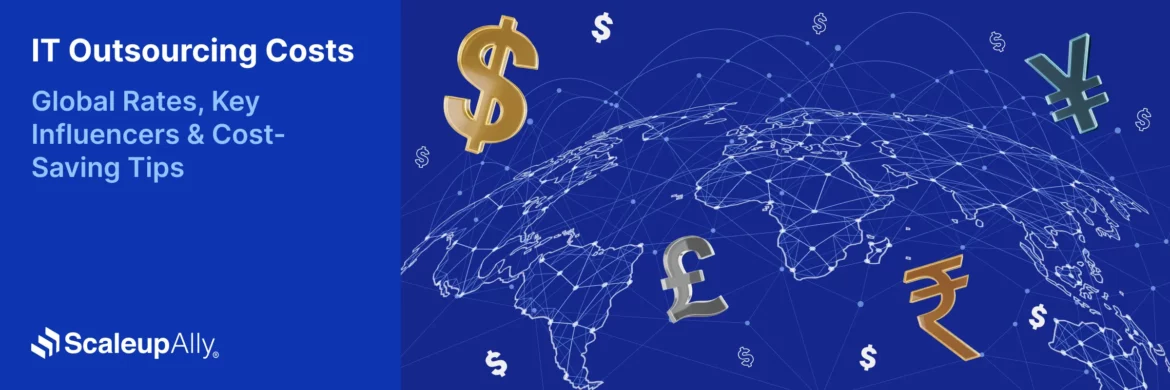
Outsourced Product Development: The Definitive Guide You Need
Pranay Agrawal | January 30, 2024 , 10 min read
Table Of Content
Outsourcing product development is a widely used business tactic, with 74% of global companies currently outsourcing their IT operations. This approach allows businesses to lower expenses, hasten the time it takes to bring products to market and tap into specialized expertise and resources.
Successful outsourcing of product development demands thorough planning, effective management, and precise execution.
If you are curious about the specifics of outsourcing, you can discover the answers in this comprehensive guide to product development outsourcing.
We’ll look into the advantages of outsourcing, key considerations when outsourcing product development, the step-by-step outsourcing process, and other relevant topics.
Key Takeaways
- Outsourcing product development helps startups and businesses reduce costs and accelerate time-to-market.
- A successful outsourcing strategy starts with clearly defining goals, identifying the right partner, and assessing their technical expertise, past work, and communication practices.
- Effective outsourcing requires strong alignment on strategy, flexible scalability, regular progress monitoring, and transparent communication throughout the engagement.
- Legal safeguards, data security, and detailed contracts are essential to protect intellectual property and ensure compliance.
- Using agile methodologies, pilot projects, and continuous improvement practices fosters collaboration and helps deliver high-quality products.
What is Outsourced Product Development?
Outsourced Product Development (OPD) refers to the strategic practice of delegating the design, development, and maintenance of a product to external service providers or third-party vendors.
This approach allows businesses to leverage the expertise and resources of external entities, often specialized in various aspects of product development.
In the context of OPD, companies collaborate with external partners to execute specific tasks or the entire product development life cycle.
This can include activities such as software development, engineering, testing, quality assurance, and ongoing support and maintenance.
Benefits of Outsourcing Product Development
Outsourcing product development can bring numerous advantages, especially for startups looking to navigate the competitive business environment efficiently and affordably.
Let’s explore these benefits, highlighting their importance with data-driven insights.
1. Cost Optimization
Data Insight: According to a study by Deloitte, 59% of companies cite cost reduction as a primary driver for outsourcing.
Benefit for Startups: Startups often operate on limited budgets. Outsourcing allows them to access skilled talent without the hefty overhead costs associated with in-house development.
2. Access to Global Talent Pool
Data Insight: A survey by Statista indicates that 74% of companies outsource to gain access to a broader talent pool.
Benefit for Startups: Outsourcing transcends geographical limitations, enabling startups to tap into a diverse range of expertise not readily available within their local talent pool.
3. Time-to-Market Acceleration
Data Insight: According to a report by McKinsey, outsourcing can reduce time-to-market by 15-30%.
Benefit for Startups: Outsourcing facilitates quicker development cycles, allowing startups to seize market opportunities promptly.
4. Focus on Core Competencies
Data Insight: The Outsourcing Institute reports that 57% of companies outsource to focus on their core business functions.
Benefit for Startups: By outsourcing non-core activities such as product development, startups can concentrate on their unique value propositions, business strategy, and customer engagement.
Factors to Consider While Outsourcing Product Development
When outsourcing product development, it’s crucial to weigh several factors to ensure a successful partnership and achieve your business objectives.
Here are some key factors to consider:
1. Strategic Alignment
Ensure that the outsourcing partner aligns with your business goals, values, and long-term vision. A shared strategic perspective fosters a more effective and collaborative working relationship.
2. Expertise and Experience
Evaluate the outsourcing partner’s expertise in the specific technology, industry, or domain relevant to your product. Consider their track record, past projects, and client testimonials to gauge their experience and capabilities.
3. Quality and Standards
Assess the outsourcing partner’s commitment to quality and adherence to industry standards. Look for certifications and quality assurance processes to ensure the delivered product meets or exceeds expectations.
4. Communication and Collaboration
Effective communication is paramount. Ensure the outsourcing partner has robust communication channels and methodologies in place. Regular updates, progress reports, and a collaborative approach enhance project transparency and success.
5. Scalability and Flexibility
Assess the outsourcing partner’s ability to scale operations based on your project needs. A flexible approach allows for adjustments in team size, resources, and priorities as your product development requirements evolve.
6. References and Case Studies
Request references and case studies from previous clients. Real-world examples provide insights into the outsourcing partner’s capabilities, communication style, and success in delivering similar projects.
How to Outsource Product Development: Step-by-Step Instructions
Outsourcing product development is a strategic decision that, when executed systematically, can yield significant benefits for your business.
Here are the step-by-step instructions to help you navigate the process effectively:
STEP 1: Define Your Goals and Requirements
Clearly articulate your business objectives, project goals, and the specific requirements for your product. Document the features, functionalities, and any other critical aspects that your outsourcing partner needs to understand.
STEP 2: Identify the Right Outsourcing Partner
Conduct thorough research to identify potential outsourcing partners. Consider factors such as expertise, industry experience, past projects, and client reviews. Create a shortlist of candidates that align with your project requirements.
STEP 3: Evaluate Technical Expertise
Assess the technical capabilities of each outsourcing partner. Ensure they have the skills and knowledge required for your specific technology stack, industry standards, and any unique aspects of your project.
STEP 4: Review Portfolio and Case Studies
Examine the outsourcing partner’s portfolio and case studies. This provides insights into their previous work, the scale of projects they’ve handled, and their success stories. Look for examples relevant to your industry.
STEP 5: Check References
Request references from the outsourcing partner and reach out to their previous clients. This step allows you to gather firsthand information about their communication, reliability, and overall performance.
STEP 6: Assess Communication Channels
Communication is key to a successful outsourcing partnership. Evaluate the outsourcing partner’s communication channels, methodologies, and responsiveness. Choose a partner that aligns with your preferred communication style.
STEP 7: Discuss Project Management Approach
Understand the outsourcing partner’s approach to project management. Discuss methodologies, tools, and timelines. Ensure they can adapt to your project’s unique requirements and provide transparency throughout the development process.
STEP 8: Clarify Pricing and Budget
Clearly define the pricing structure, including hourly rates, additional costs, and payment milestones. Transparency in pricing helps avoid misunderstandings and ensures alignment with your budget constraints.
STEP 9: Negotiate Contract Terms
Engage legal professionals to draft a comprehensive contract. Clearly outline project scopes, deliverables, timelines, intellectual property ownership, and any other crucial terms. A well-structured contract forms the basis of a successful outsourcing relationship.
STEP 10: Establish Data Security Measures
Discuss and ensure that the outsourcing partner has robust data security measures in place. Address concerns related to data privacy, confidentiality, and compliance with relevant regulations.
STEP 11: Initiate a Pilot Project (Optional)
Consider starting with a small pilot project before committing to a long-term engagement. This allows you to assess the outsourcing partner’s capabilities, work dynamics, and the compatibility of your teams.
STEP 12: Build a Collaborative Culture
Foster a collaborative and transparent culture between your in-house team and the outsourcing partner. Regular communication, updates, and a shared sense of ownership contribute to a successful partnership.
STEP 13: Implement Agile Methodologies
Consider adopting agile methodologies in project management. Iterative development cycles, regular feedback, and flexibility are crucial for adapting to evolving project requirements.
STEP 14: Monitor and Evaluate Progress
Regularly monitor the progress of the project. Implement performance metrics and evaluation criteria to ensure that the outsourcing partner meets the agreed-upon milestones and quality standards.
STEP 15. Establish Continuous Improvement Practices
Encourage a culture of continuous improvement. Regularly assess and refine processes based on feedback and performance data to optimize the efficiency and effectiveness of the outsourcing partnership.
How can Scaleupally help you?
Scaleupally offers end-to-end solutions to propel your project from conception to reality. With a diverse team of technical experts, we excel in crafting customized products tailored to your unique needs.
Whether you’re a startup seeking innovative solutions or an established business looking to scale, Scaleupally provides scalable development teams, agile methodologies, and strategic consulting to ensure success.
Scaleupally is poised to elevate your product development journey, delivering high-quality, industry-specific product ideation and design services to meet your business objectives.
Conclusion
In summary, choosing to outsource product development is a smart move that requires careful thought and thorough planning. As we’ve discussed in this detailed guide, startups and businesses can gain many advantages by teaming up with outside specialists. These benefits include saving money, tapping into a wider pool of skilled workers worldwide, getting products to market faster, and reducing risks.
Frequently Asked Questions
Q: What are common challenges in outsourcing product development, and how can they be mitigated?
Challenges may include communication gaps, data security concerns, and potential differences in time zones. Mitigate these by selecting a partner with a proven track record, implementing contractual agreements, and fostering transparent communication channels.
Q: Can outsourcing product development really save costs without compromising quality?
Yes, outsourcing can lead to cost savings without compromising quality if approached strategically. Look beyond just the hourly rate, evaluate the partner’s expertise, and consider factors like time zone advantages and access to a diverse talent pool.
Q: Are there any specific industries that benefit more from outsourcing product development?
While outsourcing is applicable across industries, it is particularly beneficial for industries requiring specialized technical expertise, such as software development, where access to a global talent pool can enhance innovation and efficiency.
Related Blogs

Top 20 Emerging Technologies of 2026
Discover the top 20 emerging technologies of 2026. Explore which innovations are driving change across healthcare, finance, manufacturing, and other crucial industries.
ScaleupAlly Team
Dec 16 ,
9 min read

IT Outsourcing Costs Explained: Global Rates, Key Influencers & Cost-Saving Tips
Discover what IT outsourcing costs include, key pricing factors, hidden fees, regional rates, and how to pick a cost-effective outsourcing partner.
Pranay Agrawal
Nov 29 ,
13 min read

IT Consulting Rates Per Hour in 2025: Country & Industry Wise
Discover IT consulting rates broken down by experience, specialization, industry, and country. Plan your budget and find the right IT talent for your business needs.
Pranay Agrawal
Nov 25 ,
13 min read



